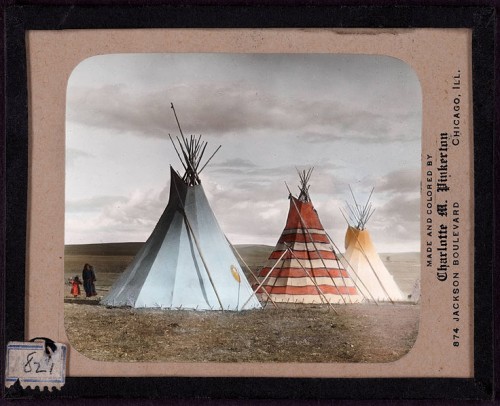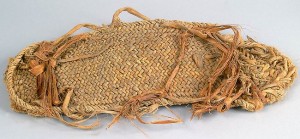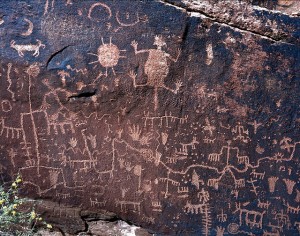 Today, I’ll wrestle with a question that Ann posed during our birthday celebration: People have been living and building things in North America for tens of thousands of years, the same tens of thousands that they’ve been in India, China, Egypt, Mesoamerica, Europe; so why do we know comparatively so little about North American paleolithics? My numbers could be off by a factor of 10 or 1000.
Today, I’ll wrestle with a question that Ann posed during our birthday celebration: People have been living and building things in North America for tens of thousands of years, the same tens of thousands that they’ve been in India, China, Egypt, Mesoamerica, Europe; so why do we know comparatively so little about North American paleolithics? My numbers could be off by a factor of 10 or 1000.
I’ve often wondered this myself, Ann. Why do most of us know so much about ancient Egyptians with their stone sarcophagi and their pyramids and mummies and Book of the Dead. And why do we often draw blanks when it comes, say, to the Mississippian peoples with their Woodhenge and their Black Drink and their towering, millennium-old earthen mounds?
Are archaeologists slipping up on the job, moving more dirt and gleaning more data in place like Egypt, Europe or India than they are here in North America (which I am defining as just the United States and Canada, in keeping with the spirit of Ann’s question)?
That’s sure not my impression as an archaeology writer. Nor could I find any evidence of it. When I keyed in “North America” and “archaeology” in Google Scholar, for example, I got a whopping 355,000 hits. By contrast, the same search for Mesopotamia and Egypt yielded just 28,300 and 148,000 hits respectively. And when I checked out the Archaeological Institute of America’s fieldwork pages, I found notices for 24 field schools programs operating in North America for 2011, 25 in Europe and just 1 in Egypt.
These are admittedly very crude measures, but I think archaeologists are laboring hard to uncover North America’s past. Each year, small armies fan out across the continent, mapping, recording, digging and analyzing sites; writing reports; blogging on the web; and publishing the most important findings. Yes, there’s a grey literature in North American archaeology, which consists of unpublished reports. But I doubt that it’s any larger than the grey literature in other parts of the world. What’s more impressive is the vast and growing body of published research on ancient North American cultures.
So if archaeologists aren’t to blame, then who is? It would be easy to point the finger at educators who are failing us, or reporters who overlook North American stories. But I personally think the problem runs much deeper. North American prehistory is all about the ancestors of Native Americans. The vast majority of North Americans, however, are either immigrants or the descendants of immigrants who plunked down on these shores sometime in the past 500 years. So most are not all that fascinated by what someone else’s long, long-dead kin were up to. It’s a little like flipping through a friend’s old family photos: the odd picture may catch our attention, but mostly our eyes glaze over. There’s no personal connection.
That’s one problem. But there’s another. And this relates to the specific nature of the archaeological record in North America, a record stretches back at least 15,000 years or perhaps a little longer, depending on who you listen to. Our continent’s archaeology is largely devoid of Old World-style monumental architecture–great temples and palaces and fortified cities crafted from stone or mud-brick. And often that puts people off, because western cultures are mad for this kind of architecture. We can instantly recognize the genius in it. I swear that if archaeologists were ever to uncover the remnants of mighty stone pyramids in the United States or Canada, throngs would instantly book tickets to go and take a look at them. They’d hunger to learn more.
 But North America’s early societies felt little need to sweat and toil on such grand projects, whose main purpose was to impress others. Instead, ancient cultures here learned to construct superbly adaptive buildings of perishable materials–wood, hide, snow, earth. That doesn’t mean these cultures were boring, unsophisticated or primitive. Far from it. In fact, the more I learn about them, the more respect I have. Long before Europeans showed up, they domesticated plants, made hide armor resembling today’s bulletproof vests, and drove thundering herds of bison over cliffs without recourse to horses.
But North America’s early societies felt little need to sweat and toil on such grand projects, whose main purpose was to impress others. Instead, ancient cultures here learned to construct superbly adaptive buildings of perishable materials–wood, hide, snow, earth. That doesn’t mean these cultures were boring, unsophisticated or primitive. Far from it. In fact, the more I learn about them, the more respect I have. Long before Europeans showed up, they domesticated plants, made hide armor resembling today’s bulletproof vests, and drove thundering herds of bison over cliffs without recourse to horses.
I bet Ann now wants to know why these smart cultures had little time for monumental architecture or little need for writing systems to record their thoughts, histories or business transactions. That, I’m afraid, will have to wait for a future post.
Top Photo, Lantern Slide of Red Stripe Tipi and Thunder Tipi, taken by Walter McClintock, Courtesy Yale Collection of Western Americana, Beinecke Rare Book and Manuscript Library. Middle, Petroglyphs in Petrified National Forest, courtesy National Park Service. Bottom, Yucca leaf sandal from Chaco Canyon, courtesy National Park Service.

Yes, Heather, that’s exactly what I want to know next. They did, after all, build mounds and pyramids — why did some do that and not others? P.S. It’s a pleasure watching a good science writer trying to find the science in a vague general question.
I grew up in Southern Illinois and as a child I’ve been to Cahokia Mounds, they are plenty grand and you can see the St. Louis arch on a clear day when your standing at the top.
The mounds were made of earth because there are very few slabs of stone throughout the area. Most of Southern Illinois consists of clay because of the glaciers scrapping it flat thousands of years ago.
As for education, it’s because every school in this country has it’s education dictated by politicians instead of academics. Thankfully in Maine, the state law requires the teaching of Wabanaki history in the schools. As for the “friend’s family album” I don’t think that’s it at all. The U.S. prior to WWII was constantly trying to ‘keep up’ with Europe and was heavily influenced by its culture. Men were actually required to learn classical literature in the 1800’s to get into college.
I also think that we simply don’t want to hear about what we as Americans have destroyed, the same is probably true of all first peoples’ histories in various lands (U.S., Australia, Japan, etc.).
It seems to me that the North American settlers never made it far out of the hunter-gatherer phase. It takes alot of free time to develop a culture and eventually make impressive buildings/art/etc.
Read Diamond’s “Guns Germs and Steel” (though I could barely slog through it).
Are there books about ancient Native American societies you’d recommend?
Hi Heather,
This is a great article!
To your first point about why we do not care about North American ancient history: Are you suggesting that the interest first starts with the people of that nation and then fans out to everyone else? I suppose there are more people than not, in western society, who share some ancestry – whether blood, ideals, or by technological sharings – with Egyptians or Sumerians.
I am very surprised that you did not mention writing as one of the reasons why we are fascinated. Or agriculture.. perhaps it’s the culmination of these things that are very much still important to Western society to this day. I am not immediately aware of much technology that were assimilated into our culture from native North Amercans.
I cannot wait until the next installment!
Travis
You point ‘construct[ing] superbly adaptive buildings of perishable materials’ seems particularly relevant to the potential resource problems we face. What is the best pop-arch reading (in a pop-sci vein) for the non-archaeologist who wants to learn more ?
Dear Heather,
I must thank you for your approach and as one commented:”I also think that we simply don’t want to hear about what we as Americans have destroyed, the same is probably true of all first peoples’ histories in various lands “, I like to say a little more, Americans do not like to tell the young generation about the systematic genocide, destruction of culture heritage of those great people who were not so interested about GOLD but more interested about the freedom…